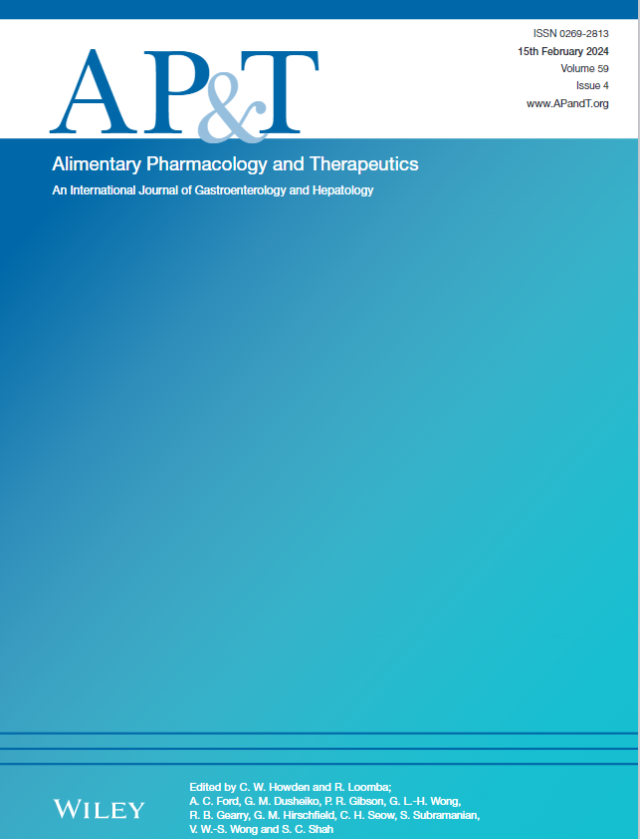Long‐Term Follow‐Up of Patients in a Prospective Study of NA Discontinuation Identifies Different Patterns of HBsAg Loss
IF 6.7
1区 医学
Q1 GASTROENTEROLOGY & HEPATOLOGY
引用次数: 0
Abstract
Background and AimsDiscontinuing nucleos(t)ide analogues (NAs) may lead to functional cure (HBsAg loss) in selected patients with chronic hepatitis B (CHB). We evaluated the rates and predictors of HBsAg loss during long‐term follow‐up in a prospective cohort.MethodsThis real‐world extension study followed participants from a prospective trial of NA discontinuation. All patients had HBeAg‐negative CHB without cirrhosis. Efficacy outcomes (including HBsAg loss and decline) and safety outcomes [including hepatitis flare and hepatocellular carcinoma (HCC)] were evaluated.ResultsAmongst 97 participants (85% Asian), with a median follow‐up of 7 years, the cumulative incidence of HBsAg loss was 10%, 13% and 22% at 5, 7 and 9 years after stopping NA. HBsAg loss was associated with a lower end‐of‐treatment (EOT) HBsAg level (HR = 0.28,在一项前瞻性研究中,对NA停药患者的长期随访确定了不同类型的HBsAg损失
背景和目的在某些慢性乙型肝炎(CHB)患者中,停用核苷类似物(NAs)可能导致功能性治愈(HBsAg丢失)。我们在一个前瞻性队列中评估了长期随访期间HBsAg损失率和预测因素。方法:这项现实世界的扩展研究跟踪了NA停药前瞻性试验的参与者。所有患者均为HBeAg阴性CHB,无肝硬化。评估了疗效结局(包括HBsAg损失和下降)和安全性结局(包括肝炎爆发和肝细胞癌(HCC))。结果在97名参与者中(85%为亚洲人),中位随访时间为7年,在停用NA后5年、7年和9年,HBsAg损失的累积发生率分别为10%、13%和22%。HBsAg损失与治疗末期(EOT) HBsAg水平(HR = 0.28, p < 0.001)、年龄(HR = 1.14, p = 0.005)和治疗结束后HBV DNA峰值水平(OR = 0.50, p = 0.002)相关。EOT HBsAg水平≤10 IU/mL的参与者在没有ALT耀斑的情况下经历了早期HBsAg损失(96周),而那些EOT HBsAg水平≥10 IU/mL的参与者经历了晚期(≥96周)HBsAg损失,通常是在ALT耀斑之后(5/8例)。无肝失代偿、肝移植及死亡病例发生。中位肝硬度未增加。3人被诊断为HCC(4.4/1000人-年)。结论功能治愈率在长期随访中有所提高,但仍处于较低水平。EOT对HBsAg损失的可能性和时间有很强的预测作用。ALT耀斑与HBsAg下降有关,在某些情况下,与延迟的HBsAg损失有关。试验注册:临床研究由国家卫生与医学研究委员会支持,研究临床试验ID为NCT02581033
本文章由计算机程序翻译,如有差异,请以英文原文为准。
求助全文
约1分钟内获得全文
求助全文
来源期刊
CiteScore
15.60
自引率
7.90%
发文量
527
审稿时长
3-6 weeks
期刊介绍:
Alimentary Pharmacology & Therapeutics is a global pharmacology journal focused on the impact of drugs on the human gastrointestinal and hepato-biliary systems. It covers a diverse range of topics, often with immediate clinical relevance to its readership.

 求助内容:
求助内容: 应助结果提醒方式:
应助结果提醒方式:


